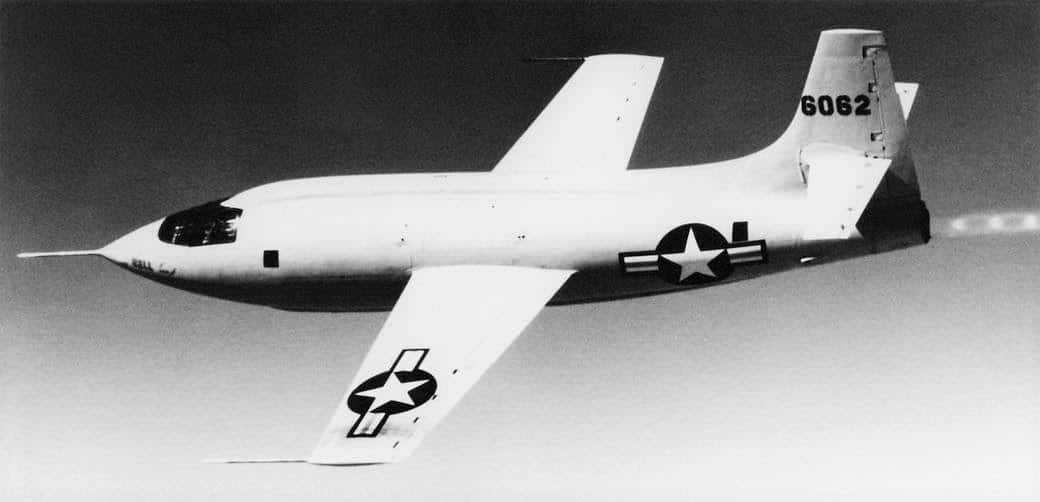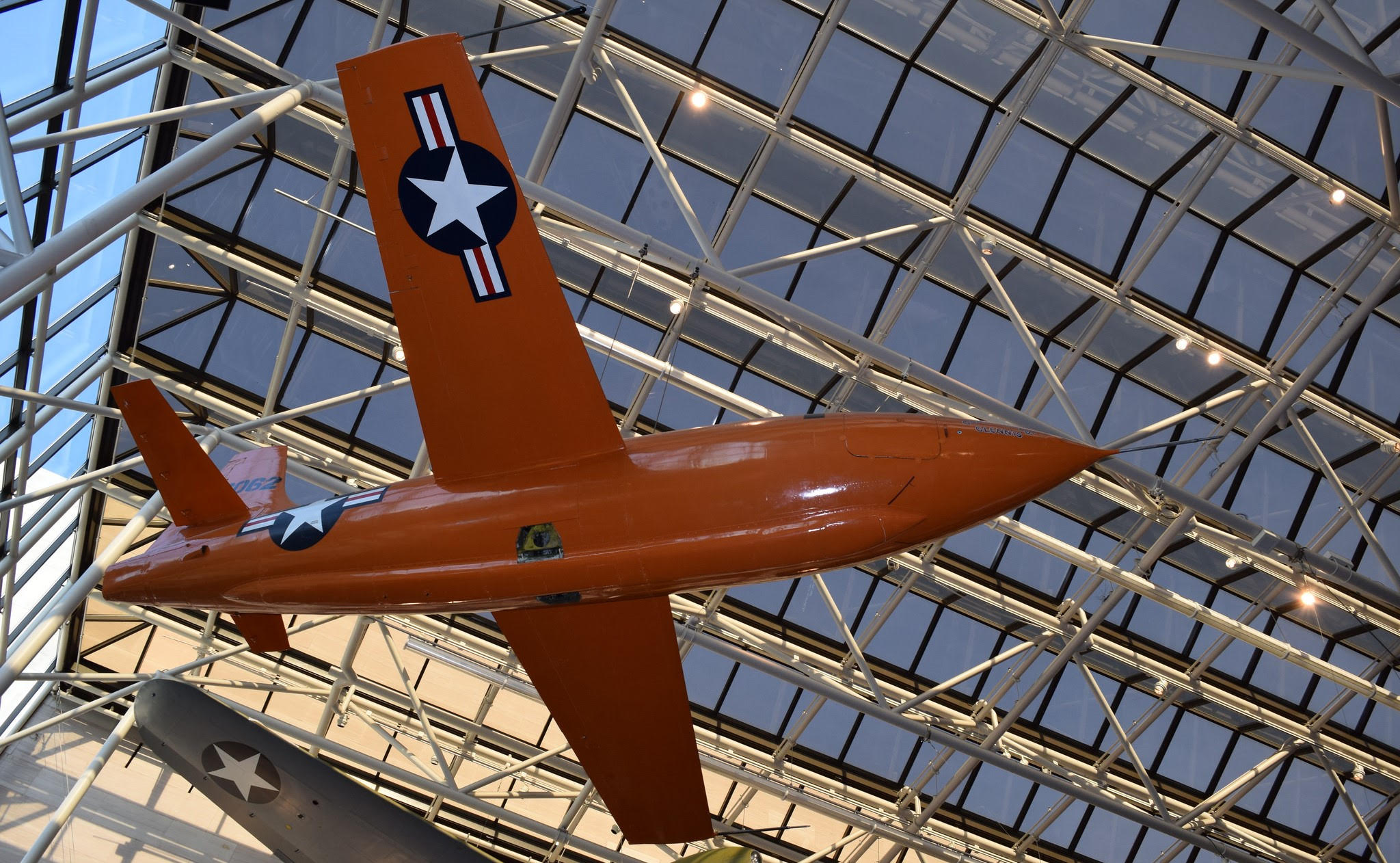“Hey Ridley, you got any Beemans?”
On a sunny autumn morning in the middle of the California desert, a pair of sonic booms echoed loudly across the blue sky signaling the greatest achievement in aviation as the thrust of the jet age propelled America toward the space age.
On 14 October 1947, then-Capt. Charles “Chuck” Yeager soared faster than any person before him as he piloted the Bell XS-1 just beyond the speed of sound.
Dropped from the belly of a B-29, the XS-1, named the Glamourous Glennis after his wife, climbed up to 45,000 feet and then flew straight and level above the Mojave Desert floor and reached Mach 1.07.
Chuck Yeager remains the greatest test pilot America has ever known.
The Road to Mach 1: Yeager Didn’t Think It Could Be Done
However, in the days leading up to that now famous date, Yeager doubted the Air Force could ever achieve Mach 1. Six days earlier, as his XS-1 raced towards that “demon in the sky”, Yeager’s aircraft had lost elevator control. He would try again.
In 1985, General Charles Yeager published a detailed account of his part in the XS-1 program as a part of his autobiography, Yeager. The book arrived in bookstores two years after the popular motion picture, The Right Stuff, was released. The movie introduced Gen. Yeager to a new generation interested in aviation.
The Making of an American Legend
Born on 13 February 1923, in Myra, West Virginia, Yeager entered the US Army Air Force (USAAF) at 18—a few months prior to the events of Pearl Harbor and the US entry into World War II. He began as a private working as an aircraft mechanic, and moved up to flight training earning his wings one month following his 20th birthday.
He became an fighter ace during the war, including being credited with downing five German Messerschmitt aircraft in one mission in October 1944. In the closing years of the war, Yeager piloted the newer P-51D Mustang during air combat.
As 1947 arrived, Yeager found himself still active in the Air Force. An offer from the forerunner of NASA, the National Advisory Committee for Aeronautics, lead him to attempt super sonic flight. The NACA planned his flights, including several hundred pounds of monitoring systems aboard the aircraft to record the performance of the Bell aircraft.
As the ‘orange beast’ neared Mach 1 during previous flights, Yeager encountered an aerodynamic condition in which the air became more dense the faster he flew. As the XS-1 reached around Mach .95, shock waves of compressed air formed around the aircraft, and the aircraft’s elevator controls suffered. Yeager refereed to this buffeting condition as “compressibility”, and he saw this as he flew the Mustang late in World War II.
The actual speed of sound varies the higher an aircraft flies. Yeager noted, “At sea level, the speed of sound is 760 m.p.h., at 40,000 feet, it is 660 m.p.h. Yeager and the NACA understood this and modified the XS-1’s tail section.
The Flight that Changed Everything
Two days prior to Yeager’s ninth powered flight on 14 October, he and wife Glennis went horse back riding following dinner on a moonless evening. Yeager’s account of what happened next became a historic footnote. As Chuck and Glennis raced back home, the dark night disguised the closed gate ahead. Yeager’s horse stopped suddenly upon hitting the gate and Yeager flew into the air and landed on the ground.
He laid flat on his back—”I was knocked silly,” Yeager said—and Glennis raced to his aide. He had suffered two cracked ribs and a sore shoulder in the fall. His planned historic flight was only 36 hours away. The morning after the fall, Glennis drove Yeager to a small town doctor who taped up his ribs.
On Tuesday, 14 October 1947, at 0800 local time, Yeager ingressed the B-29 mother ship. The Bell X-1 was underneath her belly. Once airborne, Yeager was informed that it was time, and he rode down the slide ladder inside the B-29’s mid-section to enter the Bell aircraft.
As Yeager has said, he asked for a stick of Beemans chewing gum from his friend and the B-29 flight engineer, Jack Ridley. Aviators loved Beemans—it was their lucky gum—and it also served as an antacid. He sat down, and, using a broom stick cut to size by Ridley preflight, Yeager was able to close the Bell’s canopy from the inside to aid from hurting more due to his cracked ribs.
The X-1 was dropped at 20,000 feet and Yeager immediately became a pilot as he noticed the aircraft begin to stall. He fought the craft and won, and then flipped four cockpit switches to fire the four rocket chambers of the single engine. He was on his way.
He flew up to and then leveled off at 42,000 feet while traveling at .96 Mach, “I noticed the faster I got, the smoother the ride,” Yeager noted in his autobiography. Yeager added that the next thing he noticed was that the Mach needle indicator tipped right off the scale.
“We were flying supersonic, and it was as smooth as a baby’s bottom,” he stated in his book. He radioed Ridley flying miles away in the B-29, “Hey Ridley, that Machmeter is acting screwy—it just went off the scale on me.” He added later that he felt numb but elated at what had just happened.
He had punched that hole in the sky.
Yeager mentioned in his book, “In December 1947, Aviation Week leaked the news of the sound barrier flight, but it wasn’t until the following June that the Air Force confirmed it.”
Yeager’s Legacy is a Part of American History
Even after hanging up his uniform, Yeager never stopped flying. Through the ’80s and ’90s, he climbed into the cockpits of the newest Air Force jets, always drawn back to the sky. His favorite was the F-15 Eagle, and it was in an Eagle that he went supersonic again at the age of 89, streaking over the Mojave at Mach 1.4 on 14 October 2012, just as he had in the Bell X-1 six decades earlier. Asked what went through his mind, he just smiled: “Nothing. Flying is flying.”
While the world marveled at skydivers and new technology (in the Red Bull Stratos project that same day, Felix Baumgartner jumped from 128,000 feet over New Mexico, free-falling past Mach 1 to become the first person to break the sound barrier without a jet or spacecraft), Yeager showed that courage and curiosity never go out of style.

Today, over 75 years following his mach-transcending flight, that Bell X-1 remains on permanent display at the Smithsonian Air and Space Museum in Washington.
Brigadier General Charles Elwood Yeager lived to the age of 97, passing away on 7 December 2020 in Los Angeles, California.
You can learn more about the legacy of this American Hero at his official web site.
(Charles Atkeison reports on aerospace and technology. Follow his updates via social media @Military_Flight.)
